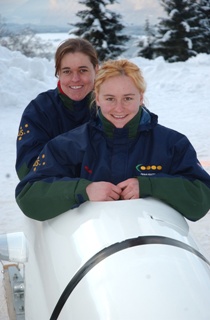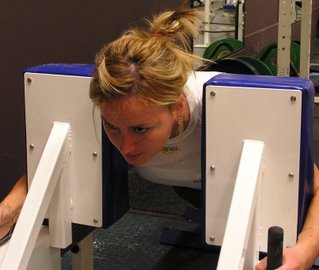 Fifth-year veterinary science student Astrid Loch-Wilkinson was the pilot of Australia’s first-ever women's bobsleigh team which competed at the Winter Olympics in Torino, Italy, in February. Astrid and brake woman Kylie Reed finished 14th with a time of 3 minutes 55.11 seconds for their four runs.
Fifth-year veterinary science student Astrid Loch-Wilkinson was the pilot of Australia’s first-ever women's bobsleigh team which competed at the Winter Olympics in Torino, Italy, in February. Astrid and brake woman Kylie Reed finished 14th with a time of 3 minutes 55.11 seconds for their four runs.Athletes from power sports such as weight-lifting and athletics are often recruited for bobsleighing because they have appropriate attributes to gain an edge at the explosive push-start that characterizes the event. Astrid had the necessary athletic ability having been an Australian national 400m hurdling champion and a Sydney University Blue in soccer.
For her strength training she turned to Martin Harland, the University's Athlete Performance Manager, himself a former Winter Olympian in the bobsleigh. Harland was very impressed by Astrid's excellent training ethic and innate capacity for strength development.
In addition to conventional basic strength exercises such as the squat and dead lift the pair made extensive use of the ScrumTruk at the university gymnasium. The machine has strong specificity for the bobsleigh push-start because in both activities force has to be generated and delivered in the horizontal plane.
"I used the ScrumTruk regularly in my strength training leading up to the Olympics," says Astrid. “I found the machine was great to use in conjunction with my Olympic lifting training. It assisted me in becoming stronger in the 'pushing' action related to bobsleigh".
Careering down a twisting track of ice at 125 kph in a flimsy shell would seem to require extraordinary courage. “My first run down the ice in a sled was terrifying as I basically had no idea what I was doing,” she admits. But after three years of piloting bobsleds in World Cup races, she says she is used to the speed.
“It becomes slower and slower the more I race. Before each race I study the track very intensively with my coach so I know precisely how to steer every part of it. I enjoy racing but it’s pretty intense and it doesn’t feel fast because I have to concentrate on the technique”, she says.
Some of the bobsleigh teams competing in Torino had million dollar budgets. By contrast Astrid and Kylie were largely self-funded. Because of Australia's isolation from alpine sports, much of their initial training consisted of pushing a billy-cart - a form of wheeled trolley used by children - around a local football oval. They were also required to travel to Europe for extended periods each year racing on the World Cup circuit.
“Bobsled racing costs $30,000 to $40,000 a year”, Astrid says. “I would like to go to the next Winter Games at Vancouver in 2010 but we need some funding”.
Read more...













